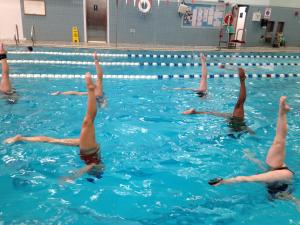Big money donors make up most Congressional campaign funding in Conn.
Posted: October 23, 2014 Filed under: Politics Leave a comment »A Public Interest Research Group study released this week says big-money donors make up a significant majority of funding for the most recent Congressional primaries in Connecticut. Seventy-one percent of all donor money in Connecticut came from donors who gave more than a thousand dollars. That ranked Connecticut 16th in the country for its percentage of big donations. (New York came in 5th).
Evan Preston of the Connecticut Public Interest Research Group says he’s concerned about the implications of that.
“The voices of the people that are only small donors are harder and harder to be heard,” Preston said. “Because if you can run your campaign by simply raising the money from that very small group of people that can afford to give that much then you won’t need to or have any reason to reach out to small donors and ordinary Americans that can give the amount that would make them a small donor.”
The study says 106 Connecticut donors gave enough to match all donations in each state of $200 or less.
“If the people that can determine who can run for office are just a small subsection of the population, then that poses a real problem for which issues can be discussed in the campaign,” Preston said.
Fed Chair Yellen says US experiencing widening inequality
Posted: October 17, 2014 Filed under: Uncategorized Leave a comment »
Federal Reserve Chairman Janet Yellen speaks during a conference on economic opportunity at the Federal Reserve Bank in Boston, Friday, Oct. 17, 2014. Yellen said that the last several decades have seen the most sustained rise in income inequality in a century. (AP Photo/Michael Dwyer)
In a speech to a Boston conference on economic opportunity, Yellen said this problem is of great concern to her and she pointed to increased education and ownership of small businesses as two ways to deal with the problem.
“It is no secret that the past few decades of widening inequality can be summed up as significant income and wealth gains for those at the very top and stagnant living standards for the majority,” Yellen said in her remarks to a conference on economic opportunity sponsored by the Federal Reserve Bank of Boston.
“Society faces difficult questions of how best to fairly and justly promote equal opportunity,” Yellen said. But she said she did not plan to offer solutions to these “contentious questions” but instead used her remarks to describe the landscape of inequality as it exists today.
She did talk about such factors as early childhood education, affordable higher education, business ownership and inheritances as “building blocks” that could be used by Americans to boost wealth.
“In focusing on these four building blocks, I do not mean to suggest that they account for all economic opportunity, but I do believe they are all significant sources opportunity for individuals and their families to improve their economic circumstances,” Yellen said.
In her Boston speech, Yellen made no comments on the current state of the economy or on the future course of interest rates.
The Fed next meets on Oct. 28-29 and many economists believe the recent financial market turbulence and downgrades to economic prospects around the globe increase the likelihood that the central bank will not start raising its key short-term interest rate until next summer. That rate has been at a record low near zero since December 2008.
Connecticut’s disparity is inverted when it comes to mental health coverage
Posted: October 13, 2014 Filed under: Health Leave a comment »When it comes to coverage of mental health care for children in Connecticut, there’s an unusual inversion of the state’s economic disparity. Parents and health care providers say it’s easier for low-income children on the state’s Husky Medicaid plan to get certain care options covered than kids whose parents have private insurance. (We’ve talked about this on State of Disparity before).
Now Connecticut is proposing a new plan to cover mental health care for kids. It involves pooling both public money and money from private insurers. And the plan is getting mixed reviews. Craig LeMoult’s story on the the plan is online here.
Nicholas Kristof & Sheryl WuDunn discuss ways to address opportunity gap
Posted: October 3, 2014 Filed under: Education, General, Income Leave a comment »Pulitzer Prize-winning journalists Nicholas Kristof and Sheryl WuDunn’s new book “A Path Appears” looks at barriers to opportunity around the world, and what can be done to overcome them. Some of those barriers are already in place at the beginning. As WuDunn puts it, some kids are born “behind the starting line.” She says a child born in the bottom 20 percent of the economic spectrum has a one in 12.7 percent chance of making it to the top 20 percent.
WuDunn and Kristof spoke at Sacred Heart University on Friday to talk about the book. WSHU’s Craig LeMoult asked them about the gap, and how it can be addressed with early intervention.
WuDunn says by the age of four, a child of professionals has heard 30 million more words than the child of parents on welfare. That gap can make a significant difference in a child’s development.
“Part of that is an income issue,” says Kristof. “People don’t have resources for babysitter, or may send somebody to a child care program that may be inadequate. But it’s also, to some degree, cultural.”
Kristof says the gap between wealthy and poor children is increasing.
“Middle class parents have been investing more and more and more in their kids’ enrichment programs, and sending their kids to music lessons, then chess lessons, and soccer practice,” he says. “So the gap in those enrichment programs has gotten greater over the last generation, rather than smaller.”
But, Kristof says, it’s a mistake to think there’s not much that we can do to narrow that gap. Here’s what they had to say about early interventions that can make a difference:
“There are very very few people who don’t want the best for their kids,” says Kristof. “And where there are shortcomings, they may be raising their child the way they were raised. And if they get some support, some parental coaching, some help – especially with the incredibly difficult job of being a single parent – then they can dramatically improve those outcomes.”
In particular, Kristof and WuDunn point to the effectiveness of the Nurse Family Partnership, which provides coaching to new parents, even before a child is born. Teaching parents not to smoke or drink, and to breastfeed and hug a baby, can have a huge impact on a child’s development. They say families who get coaching from the Nurse Family Partnership see a 79 percent drop in state-verified child abuse, and the children are half as likely to be arrested by age of 15.
A program that’s working to close that 30 million word gap is Reach Out and Read, which provides books to low income families to help with the cognitive development of children. The program provides books, and doctors “prescribe” nightly bedtime stories to families. Here’s Kristof and WuDunn describing the program.
The cost is $20 per child per year. But Kristof says only a third of children who would benefit from the program in the U.S. get that intervention.
Kristof says unlike the U.S., economic inequality has declined globally. In particular, he says one of the great global changes has been an increase in literacy.
You can hear the full audio of Kristof and WuDunn’s discussion here.
The power of youth sports, at different spots along the economic spectrum
Posted: October 2, 2014 Filed under: Uncategorized Leave a comment »There are some things that are constant, no matter where on the economic ladder people find themselves. And it can be telling to look at the differences, and the commonalities.
Two stories on WSHU recently have looked at very different experiences in youth sports.
First, we visited the YMCA in the wealthy town of New Canaan, Connecticut, to see middle school and high school girls compete in one of the top teams in the country in… synchronized swimming.Synchro, as they call it, is certainly not your usual after school sport. And that’s part of why these girls love it so much.
Here’s Craig LeMoult’s story on the team.
You can see video and a photo slideshow of the synchro team here.
One reason you don’t see a synchronized swimming team in every town might be the expense. One coach estimated the cost could average $10,000 to $12,000 a year, including coaching fees, a lot of travel, and of course glittery bathing suits. And those bathing suits don’t just glitter themselves. Parent involvement is key – one swimmer said her mother spent hours applying that glitter. One family moved to Connecticut from Pennsylvania so that their daughter could train on the New Canaan team.
On the other end of the spectrum, we checked out a gym in the Dixwell neighborhood of New Haven, where former Golden Gloves champ Devonne Canady is teaching kids between the ages of 8 and 12 to box. The gym is named the Elephant in the Room Boxing Club. To Canady, the “elephant in the room” is gun violence. She’s teaching boxing to keep these kids off the streets where they can be hurt, and to keep them focused on something positive so they don’t go down the wrong path. Here’s Craig’s story:You can see video and a photo slideshow of the boxers here.
“I grew up right here,” Canady said. “And unfortunately, the children in this neighborhood, this particular neighborhood, there isn’t a lot for them. There isn’t a rec center. There’s barely parks. If there’s parks, there’s no swings. There’s not a soccer field.”
Canady charges $20 a month to train a kid in the gym, and she’s willing to be flexible if that’s too difficult for families.
Of course, there’s a lot that’s different about the Y synchro team and the Elephant in the Room Boxing Club. First of all, there’s the background the kids are coming from. It’s the difference between providing a sport that will look good on a college application and coaching one to prevent kids from being shot. And it’s the difference between $12,000 a year and $240 a year.
And sure, there are plenty of other differences. But despite all that, it’s the similarities that are the most striking. Both sports require a significant time commitment and hard physical work from the kids. All that time and work is aimed at improving an ability that’s equal parts strength and style. Both sports teach kids the importance of discipline and focus. Both are coached by passionate women who are driven to see the kids perform their best.
And, hopefully, both will lead to kids who grow up stronger, smarter and more ready to succeed – whether it’s in a ring, in a pool, or anywhere else.
(WSHU’s Craig LeMoult reported the two stories mentioned, and wrote this post. He’s the founder of State of Disparity)




Recent Comments